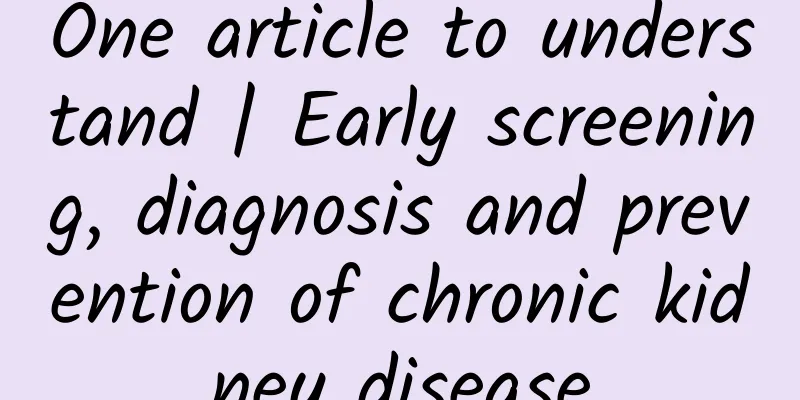One article to understand | Early screening, diagnosis and prevention of chronic kidney disease

|
CKD is a global public health problem with high morbidity, low awareness, poor prognosis and high medical costs. It not only seriously endangers the health of patients, but also brings a serious economic burden to society. Therefore, early screening, timely diagnosis and treatment are very important for CKD patients. Yilu Shenkangte has compiled the early screening, diagnosis and prevention of CKD for clinical reference. Diagnosis and staging of CKD CKD is defined as abnormal kidney structure or function for more than 3 months. CKD can be diagnosed based on markers of kidney damage and/or decreased glomerular filtration rate (GFR) for more than 3 months. CKD is divided into stages 1 to 5 based on GFR levels. The risk stratification of CKD is based on eGFR staging and proteinuria grade, which is divided into stage 1 (low risk), stage 2 (intermediate risk), stage 3 (high risk) and stage 4 (extremely high risk), as shown in Figure 1. Figure 1 Basis and criteria for risk stratification Screening for CKD CKD has an insidious onset, so early active screening and early treatment are of great significance to CKD patients. Therefore, different screening strategies should be adopted for different populations. (1) Adults: Routinely test urine albumin-to-creatinine ratio (UACR) and serum creatinine once a year. (2) People at high risk of CKD: For people at high risk of CKD (such as those with a family history of kidney disease, diabetes, hypertension, cardiovascular disease, hyperuricemia, advanced age, obesity, long-term use of kidney-damaging drugs, and a history of acute kidney injury), primary prevention should be carried out, that is, UACR and serum creatinine should be tested at least once every six months, and a comprehensive assessment and diagnosis should be conducted based on the serum creatinine value. (3) Elderly people, those with malnutrition, low muscle mass and liver dysfunction: For this group of people, eGFR based on serum creatinine is not accurate enough for the diagnosis and staging of CKD. It is recommended to test cystatin C and calculate eGFR based on the CKD-EPI formula based on the serum creatinine and cystatin C values. Prevention and treatment of CKD progression The prevention and treatment of CKD mainly include improvement of lifestyle habits, nutritional therapy, and control of proteinuria, hypertension, hyperglycemia, and high blood pressure. (1) Control proteinuria: Protein is filtered through the glomeruli and reabsorbed by the renal tubules, which can damage the glomerular filtration membrane and tubular cells, and promote glomerular sclerosis and tubulointerstitial fibrosis. Therefore, controlling proteinuria is an important therapeutic measure to delay the progression of CKD. The target of urine protein control for patients with diabetic kidney disease is UACR < 30 mg/g, and the target of urine protein control for non-diabetic patients is UACR < 300 mg/g. The guidelines recommend the use of angiotensin-converting enzyme inhibitors, angiotensin II receptor blockers, or mineralocorticoid receptor antagonists to reduce proteinuria based on UACR levels, but the combined use of angiotensin-converting enzyme inhibitors and angiotensin II receptor blockers is not recommended. When using, pay attention to the presence of bilateral renal artery stenosis, monitor eGFR and serum potassium concentration. It should be noted that eGFR < 30 ml/(min·1.73m2) is not an absolute indication for discontinuing such drugs. (2) Control blood pressure: The control of hypertension should set the blood pressure control target value according to the UACR level: when UACR≤30 mg/g, maintain blood pressure ≤140/90 mmHg (1 mmHg=0.133 kPa); when UACR>30 mg/g, control blood pressure ≤130/80 mmHg. The selection of antihypertensive drugs should also take into account the presence or absence of combined proteinuria. In order to improve the blood pressure target rate, it is recommended to use single-tablet compound preparations or combination preparations. Patients with severe hypertension can choose three or more antihypertensive drugs for combined treatment. (3) Control blood sugar: Diabetic nephropathy is one of the common microvascular complications of diabetes. Changes in renal hemodynamics and metabolic abnormalities caused by hyperglycemia are the pathological basis of renal damage. The diagnosis of diabetic nephropathy (DKD) is mainly based on a history of diabetes, a decrease in eGFR and/or an increase in UACR for more than 3 months. Retinopathy is not a necessary condition for the diagnosis of DKD. It is recommended that the target value of glycated hemoglobin be below 7.0%, and the control target should be strictly or relaxed according to factors such as life expectancy and risk of hypoglycemia. Sodium-glucose co-transporter 2 inhibitors and glucagon-like peptide-1 receptor agonists are recommended to improve renal prognosis. When using metformin and sodium-glucose co-transporter 2 inhibitors, pay attention to monitoring eGFR levels and adjust the dosage or stop using them in time. (4) Control blood lipids: Dyslipidemia is an important factor that promotes the progression of CKD and is also a major risk factor for cardiovascular and cerebrovascular diseases, renal artery atherosclerosis, and target organ damage in CKD patients. Currently, the main drugs for treating hyperlipidemia are statins. (5) Use medications with caution: When eGFR is less than 45 ml/(min·1.73m2), drugs with potential nephrotoxicity and renal excretion should be used with caution or discontinued. When iodinated contrast agents must be used, the principles of using small amounts, choosing hypotonic or isotonic contrast agents, adequate hydration during the perioperative period, and monitoring eGFR should be followed. It should be noted that CKD patients should also use over-the-counter drugs or protein supplements under the guidance of a physician or pharmacist. Prevention and treatment of CKD complications CKD patients, especially those in the late stages of CKD, have many complications and complex conditions. The prevention and treatment of complications is an important aspect of CKD prevention and treatment, and is of great significance for delaying disease progression, improving patients' quality of life, and improving prognosis. (1) Anemia: CKD patients should be monitored for anemia. Most CKD anemia patients require erythropoietin treatment. At the same time, iron status needs to be assessed to determine whether iron therapy should be used. (2) CKD-MBD: The main purpose of CKD-MBD prevention and treatment is to improve survival and reduce the risk of cardiovascular events and fractures. For patients in G3 stage, it is recommended that phosphorus intake should be limited to 800-1000 mg/d. If the blood phosphorus level is still higher than the target value, intestinal phosphorus binders should be taken. It is recommended that blood calcium concentration be maintained within the normal range. It is recommended that intact parathyroid hormone be controlled at 2-5 times the upper limit of the normal value. (3) Acidosis: The guidelines recommend that when the HCO3 concentration of CKD patients is less than 22 mmol/L, oral alkaline preparations such as sodium bicarbonate should be taken to maintain the HCO3 concentration at a normal level. (4) Hyperkalemia: Once hyperkalemia occurs in CKD patients, it is easy to recur and long-term management of blood potassium is required. Treatment measures include low-potassium diet, adjustment of the dosage of renin-angiotensin-aldosterone system inhibitors, oral potassium-lowering agents, and the use of potassium-excreting diuretics as appropriate. For acute hyperkalemia that cannot be controlled by drugs, emergency dialysis treatment is initiated. Commonly used oral potassium-lowering agents include sodium polystyrene sulfonate, calcium polystyrene sulfonate, sodium zirconium cyclosilicate, etc. In short, for the prevention and treatment of CKD, early screening, timely diagnosis and treatment are necessary, so as to minimize the harm to patients. References [1] Gao Xiang, Mei Changlin. Interpretation of "Guidelines for Early Screening, Diagnosis and Prevention of Chronic Kidney Disease (2022 Edition)"[J]. Chinese Journal of Practical Internal Medicine, 2022, 42(09): 735-739. |
<<: What is the most common inherited kidney disease?
Recommend
Is it good to do yoga during menstruation?
Practicing yoga has become a fashion. Everyone re...
What are the reasons for less menstrual flow?
For many women, bleeding from menarche to the sta...
What are the must-eat foods when traveling to Xiamen? What are the specialties of Xiamen tourism?
Xiamen is not only a beautiful coastal city, but ...
When is the best time for painless abortion surgery?
Unexpected pregnancy is a problem that many women...
What sleeping posture should you follow during late pregnancy?
In the late stage of pregnancy, the belly of preg...
Why do we feel tired easily in summer?
Ask about health丨I often feel tired during the do...
How many months of pregnancy can I have a medical abortion?
Many people encounter accidents when they are pre...
If you have diabetes, you must pay attention to this type of eye disease!
Middle-aged and elderly diabetic patients are als...
Is the body shaking when being electrocuted ventricular fibrillation?
This is the 4624th article of Da Yi Xiao Hu That ...
Can I have sex if I have uterine fibroids? Experts will tell you the answer
Many people ask whether they can have sex after s...
How to restore eyesight after confinement
After pregnancy and childbirth, the pregnant woma...
Can leucorrhea turn green and heal on its own?
Whether the leucorrhea is normal is very importan...
World Oral Health Day丨Why do some people, at a young age, have “a car parked” in their mouths?
Why do some people, at a young age, have a car pa...
What should I do if I have back pain when I am eight months pregnant?
Women often experience back pain during pregnancy...









